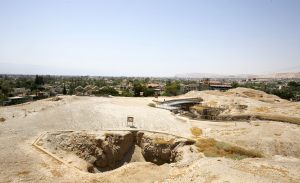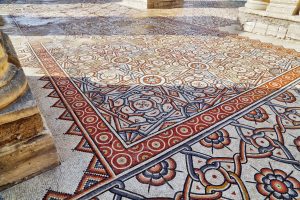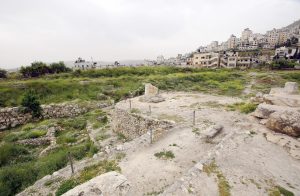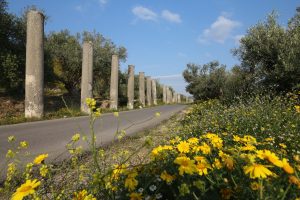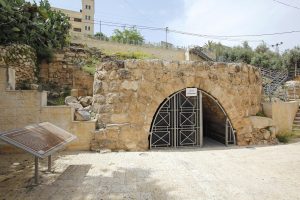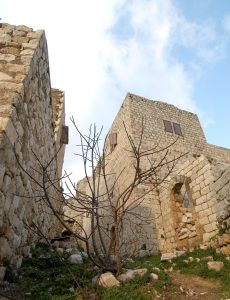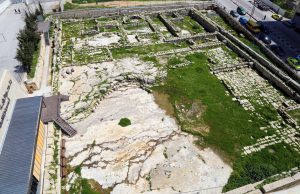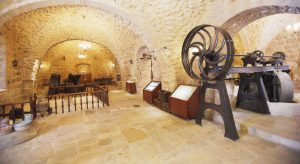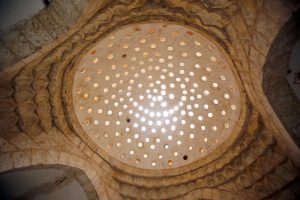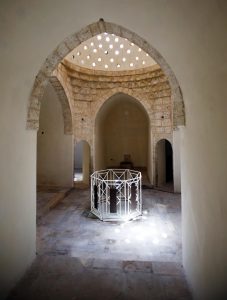The Ministry of Tourism and Antiquities (MOTA) strives to provide the best tourist services to visitors, both foreign and local, at all sites under its direct management. For this reason, MOTA ensures that all tourist sites have the necessary infrastructure, including a reception center that provides visitors with information on the history and significance of the particular sites that collectively represent the cultural heritage of the Palestinian people. Ideally, each information center would be equipped with films that introduce the sites and facilitate an understanding of their history. Some of the open heritage sites include a museum that exhibits cultural artefacts representing the site’s historical chronology. Panels and safe paths contribute to ease of movement, and shelters are sometimes installed to protect various features as well as to ensure a shady spot where visitors can gather during site briefs.
One of MOTA’s main current projects is the preparation of a shelter to protect the mosaic floor of the great audience hall at Hisham’s Palace, which will reveal the palace’s aesthetics and boost site tourism. The ministry is also working on designing brochures for each site and is keen to employ qualified staff to address the needs of visitors.
Site-services staff are responsible for a variety of tasks: receiving visitors, both individuals and groups; offering a brief overview of the site to visitors and providing them with information brochures; accompanying visitors to the interpretation center to view a film about the site and ensuring the logistics of the screening; gathering, recording, and reporting relevant data on all visitors; ensuring that the site is well maintained; collecting entry fees.
Visits to some open cultural heritage sites are free of charge, whereas visits to others require an entry fee: adults, NIS 10; adult groups (30–40 persons), NIS 300; children, NIS 5; children’s groups (30–40 children), NIS 150; university students, NIS 7; school students, NIS 1.
The main tourist sites that are under the direct supervision of the Ministry of Tourism and Antiquities are listed below and include the services provided at each location.
Tell as-Sultan
The site of Tell as-Sultan is located in the lower plain of the Jordan Valley, approximately ten kilometers north of the Dead Sea. It is known as the lowest and the oldest town on the earth. The mound where the ruins of the town were found covers an area of about one acre.
Successive excavations at the site uncovered its cultural history that stretches over 10,000 years. The earliest remains belong to the Natufian culture (10th–8th millennia BC), and consist of flint tools, which attests to the presence of a hunting Natufian camp near the spring. The remains of the early Neolithic settlement (8000–5000 BC) are represented by a settlement (town) with round houses built of mud brick and surrounded by a wall and a round tower, representing the earliest preserved piece of a fortification system. The site has also revealed some of the earliest evidence of human domestication of plants and animals in the world.
The city of ancient Jericho played a major role between the Early Bronze Age and Middle Bronze Age (3200–1550 BC). Therefore, the site was one of the main Canaanite cities in Palestine. It was mentioned in historical sources, and a recent find has the name appear on a scarab from the second millennium BC. Scanty remains at the site appeared in later periods.Tell as-Sultan is open daily between 8:00 and 17:00. The site includes an interpretation center, reception staff, and a screening room with an informative film. (Entry fee required.)
Hisham’s Palace
The site is located on the northern bank of Wadi Nueima, approximately two kilometers north of Jericho in the Jordan Valley, and is identified with the ruins of Khirbet al-Mafjar. The site was built by Caliph Hisham bin Abd el-Malik (r. 724 to 743 AD), and later decorated by his heir Al-Walid II between 743 and 744 AD. The site was not the official residence of the caliph but was used as a winter resort. The spectacular audience hall and bath were destroyed in a severe earthquake in 749 AD, but other areas of the site, including the palace, remained until the tenth century. The northern section served as an agricultural estate during the Umayyad and Abbasid periods, around 730–950 AD.
During the Umayyad period, the site comprised a palace, an audience hall with a thermal bath, a mosque, a monumental fountain within a perimeter wall, two main gates, and probably an elite residence. The first three principal buildings were arranged along the west side of a common forecourt, with a pool covered by a pavilion in its center.
The great audience hall is located north of the palace and includes a pavement of about 30 x 30 meters, with 38 colorful mosaic carpets. The building once supported a series of vaults and domes and was decorated with carved stucco, stone reliefs, and statues. Its upper parts included painted frescoes, and a long pool was added along its southern side. The caliph’s statue stood above the main entrance. The caliph himself probably sat in the recess at the far end of the hall. The thermal bath was added to the north side of the audience hall.
At the northwest corner of the reception hall is the diwan, a small guest room, with an apsidal raised platform at the northernmost end of the chamber. The room had benches on both sides. The walls and dome were richly decorated with stucco panels and columns. The floor of the diwan was paved with fine mosaics, including the world-famous scene of the tree of life.Hisham’s Palace is open daily between 8:00 and 17:00. The site includes an interpretation center, reception staff, a screening room with an informative film, and a site museum. Entry fee required. Phone number: 02 232 2522.
Tell Balata Archaeological Park
The site is identified as the Canaanite town of Shechem, which was mentioned in several ancient sources that date from the second and first millennia BC. Tell Balata lies between the famous hills of Gerizim and Ebal, where the main north-south and east-west routes of Palestine crossed. It is said to have been the hub of an extensive early road network.
Excavations have revealed much about the history of the site, particularly that it was inhabited during the Chalcolithic period (4500–3500 BC). It became an urban center during the Middle and Late Bronze Age (1800–1200 BC). Of the most impressive surviving ruins is a fortress temple, which is thought to have been used for public worship. Other visible ruins include two monumental gates, massive city walls, a governor’s palace with a small private temple, guardrooms, an assembly, living quarters, and a kitchen. Some remnants date back to the Iron Age (which began in 1200 BC) and were destroyed by the Assyrians in 721 BC. The site regained its administrative role during the Hellenistic period in 332 BC, but was abandoned during the late second century BC. In 72 AD, the Roman city of Nablus (Flavia Neapolis) was founded to the west of Tell Balata.Tell Balata Archaeological Park is open daily between 8:00 and 17:00. The site includes an interpretation center, reception staff, a screening room with an informative film, and a site museum. Entry fee required.
Sebastia (Sabastya)
Sebastia is located at the junction of two main historical routes, the northern Nablus-Jenin route and the western route from the Jordan Valley to the Mediterranean coast. The site offers a magnificent view of the surrounding farmland. It flourished during the Iron Age II as a regional capital. It was captured by the Assyrians in 722 BC during the reign of Sargun II and became the center of the Assyrian province in Palestine. Later, under Persian rule, the city remained a provincial capital for central Palestine. In 332 BC, the city was captured by Alexander the Great. Massive fortifications around the acropolis were added, including a circular tower. Then, in 63 BC, the city became part of the province of Syria. Emperor Augustus later gave it to Herod, who renamed it Sebaste (in Greek, Sebastos is Augustus) in honor of the emperor. Severus gave it the Status of Colonia in 200. A large building program was carried out during the Roman period, including the city wall, a gate, a colonnaded street with 600 columns, the basilica, the forum, a theater, a temple for Augustus, a stadium, an aqueduct, and cemeteries.
During the Byzantine period, Sebastia was the seat of a bishop. A church dedicated to Saint John was built on the southern slope of the acropolis. A Byzantine church and a Crusader church, both dedicated to Saint John, were built in the center of the old village. A mosque was also built in honor of Saint John (Nabi Yahyia).
The present town of Sebastia, including the archaeological remains, the historical town, and the cultural landscape, is one of Palestine’s major tourist attractions.Sebastia (Sabastiya) Information Center is open daily between 8:00 and 15:00. The center has a reception employee and a screening room that will later screen a film on Sebastia. Entry to the site is free of charge. Phone number: 09 253 2136.
Khirbet Bal’ama and the Water Tunnel
Located approximately two kilometers south of the main city center, the site was a fortified Canaanite city that occupied a strategic position along the historical route of Wadi Bal’ama that linked the Arraba Plain with Marj Ibn Amer. The site is identified with ancient Ibleam, which was mentioned in the Egyptian Royal Archive in the fifteenth century BC. During the classical period, it was known as Belmont, and in the medieval period as Castellum Beleismum.
Excavations at Khirbet Bal’ama led to the recovery of the ancient water system, which connected the Bir as-Sinjil Spring at the base of the mound with the inhabitants who live at the top of the site. It was designed to be used primarily in times of war and siege.
The tunnel consists of three parts: the archway at the lowest entrance, the rock-cut tunnel going upwards to the west, and the unfinished upper passage. The excavations uncovered evidence from the Bronze Age, the Iron Age, and the Persian, Hellenistic, Roman, Umayyad, Crusader/Ayyubid, Mamluk, and Ottoman periods. In 1999, a series of restorations was carried out on the site. In 2005, the tunnel was rehabilitated as an archaeological park and is now open to visitors.Khirbet Bal’ama and the Water Tunnel are open from Sunday to Thursday between 8:00 and 15:00. The site has a reception employee. No entry fee required.
Al-Barqawi Castle (Shufa)
Located in Shufa village, five kilometers southeast of Tulkarem, Al-Barqawi Castle was built on the ruins of an archaeological site from the Roman and Byzantine periods. The location of castle overlooks a wide view of the Palestinian coastal plain. The castle has reflected the emergence of the “Throne Villages” and the socio-political role played by the local political leadership during the late Ottoman period. The Barqawi family collected the tax in the region during the Ottoman period. One of the main historical figures whose name was mentioned in the written documents was Al-Sheikh Nasser Barqawi, who died in 1773 AD. The castle, which consists of two main floors and a basement, contains courtyards, more than 25 rooms, the Barqawi family residence, horse stables, an olive press, cisterns, and a prison. The floors of the castle are connected by stairs, and the roof includes domes of various sizes.
Al-Barqawi Castle (Shufa) is open daily between 8:00 and 15:00. The site has a reception employee, and entry to the castle is free of charge.
Haram al-Rama (Mamre)
Located three kilometers north of Hebron’s city center, Haram al-Rama is associated with religious traditions that stem from the story of the prophet Ibrahim/Abraham, who is said to have set up a tent in Al-Rama after parting ways with his nephew Lot. According to these traditions, the site might be the place where the prophet Ibrahim/Abraham received the three angels who informed him that his barren wife Sarah would give birth to Isaac.
Archaeological excavations undertaken in the 1920s revealed a large impressive enclosure (65 x 49 meters) constructed of stones similar to those used to build Al-Haram al-Ibrahimi.
Al-Rama grew into a thriving marketplace during the Roman period, especially during the reign of Emperor Hadrian (ca. 135 AD). It attracted merchants from Syria, Egypt, and all over Palestine. In the fourth century AD, Constantine the Great built a church inside the enclosure, which is depicted on the Madaba mosaic map, dating back to the sixth century AD. A roofed cistern with stone basins that was used to provide animals with water is still visible on the southwestern corner of the site.Haram al-Rama (Mamre) is open from Sunday to Thursday between 8:00 and 15:00. The site has a reception employee and a screening room that will later screen a film about the site. Entry to the site is free of charge.
Shajarat al-Durr Olive Press (Abdel Nabi al-Natsheh)
This olive press is located in the old town of Hebron near the old municipality square in Al-Zahid area. It is named after the Abdel Nabi al-Natsheh family that owned and operated it, and it also takes its name Shajarat al-Durr from the school on the uppermost floor of the building where the press is found.
The olive press was established at the beginning of the twentieth century during the late Ottoman period. In 1925, a grain mill was added to it. The press continued to operate until the late 1970s. The archaeological remains of the press found on site include a stone press that dates back to the Ottoman period.
During the British Mandate, the site was developed into an industrial establishment that contained a mechanical olive press and a grain mill. The establishment marks a significant stage in the technological development of extracting olive oil and grinding grain in Hebron. In fact, there was a formidable shift from the traditional practice of extracting oil by manual labor or the use of beasts of burden to modern mechanical olive presses.Shajarat al-Durr Olive Press (Abdel Nabi al-Natsheh) is open from Sunday to Thursday between 8:00 and 15:00. The site has a reception employee, a display of olive-press tools, and explanatory boards. Entry to the site is free of charge.
Hammam Sayedna Ibrahim al-Khalil
This hammam is located in Al-Dariyye Quarter near khan al-khalil, and it is one of the most important archaeological waqf endowments in the city of Hebron as well as one of the oldest Islamic public baths in Palestine. The hammam was established during the Mamluk period by an order from Emir Alaeddin Idghadi (1266–1294 AD) who took part personally in laying the foundation for the bath with the laborers, architects, and engineers. The hammam consists of three main rooms or sections with different temperatures: frigidarium, tepidarium, and caldarium. The area of the hammam is estimated at over 450 square meters.
Hammam Sayedna Ibrahim al-Khalil was supplied with water from several water springs that also supplied the old town of Hebron. The water springs included Arab springs, Sumaqiyya springs, and other springs. The hammam had two cisterns for storage of water to ensure the availability of sufficient water for its needs.Hammam Sayedna Ibrahim al-Khalil is open from Sunday to Thursday between 8:00 and 15:00. The site has a reception employee.
Article photos courtesy of MoTA.


